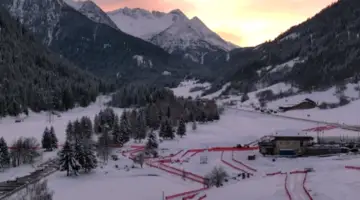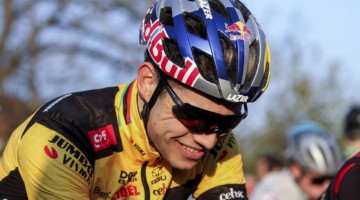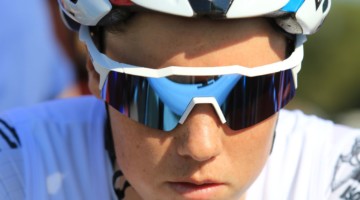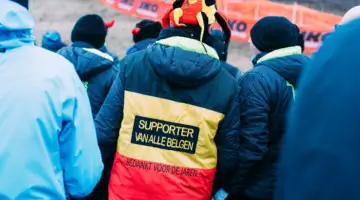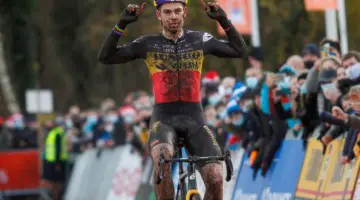by Corey Coogan Cisek
The head cold I picked up after Worlds lasted an unusually long time. I knew it would be an uphill battle to find form for my last weekend of racing at the final Superprestige in Middelkerke, Belgium and Brico Cross in Hulst, Netherlands.
Middelkerke is a seaside town. Driving there through the farm fields of Flanders, you suddenly see high-rise buildings on the horizon. Everyone in Belgium wants a home on the ocean, which explains the high rises. What is surreal is there is no real transition from countryside to ocean city. The margin between farm fields and high rises is only about a kilometer, so the city literally juts out of the farm fields.
The course at Middelkerke was both awkward and terribly demanding. It emphasizes short, sharp ups and highly technical off-cambers, interspersed with deep sand and shallow, sodden sand. The features are spaced to prevent carrying speed, forcing max power efforts to get up climbs, as well as awkward dismounts and remounts.
I had a good start and a good first lap. Then my proverbial wheels fell off. I had “no go” and had to back off to below my threshold in order to have the coordination to manage the obstacles.
Afterward, I was pretty despondent. I had finally got my technical skills to click, but I had no form. The most frightening part was I had no fight; I am usually able to count on myself to fight with tenacity. On the trainer cooling down, I was on my phone, reaching out to anyone who might understand my physical and mental state. This is not a place or state of mind I often find myself in.
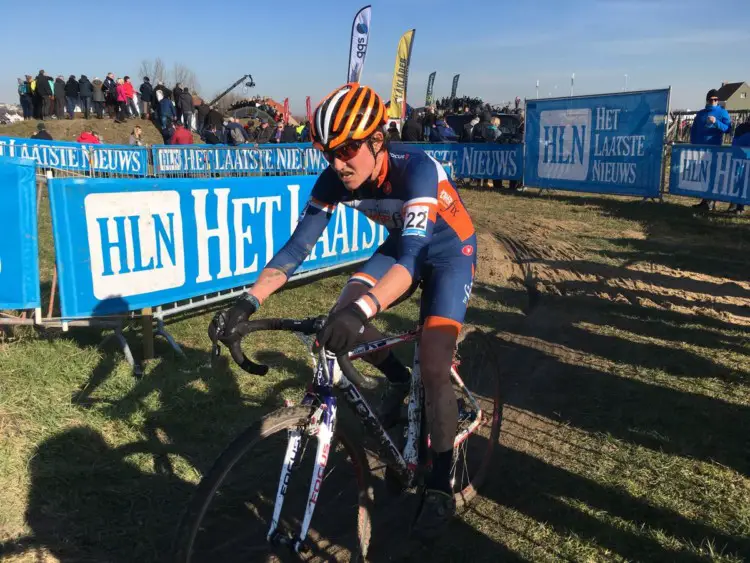
Corey Coogan Cisek at Middlekerke. Corey Coogan Cisek rider diary. © Steven De Poorter / Cyclocross Magazine
The next day, the course in Hulst, Netherlands proved the most technically intimidating of my season. The race in Hulst is a young one, a UCI C2 and part of the less prestigious Brico Cross series. It seemed course designers were driven to create a memorable course that could compete with any other European course in terms of difficulty. Among the Americans racing, there was a consensus: the course was World Cup caliber.
This being Holland, there wasn’t a hill for thousands of kilometers. Accordingly, they “made hills” by setting the course on the tall, steep banks of the canal that surrounds Hulst. The pinnacle features were terrifying descents down the banks, a long hand-over-hand climbing “run-up,” off-cambers and short, steep ups and downs. It’s fortunate that Hulst was my last race of the season, rather than my first. Had I encountered the descents early in the trip, I might have seriously considered packing my bags for home.
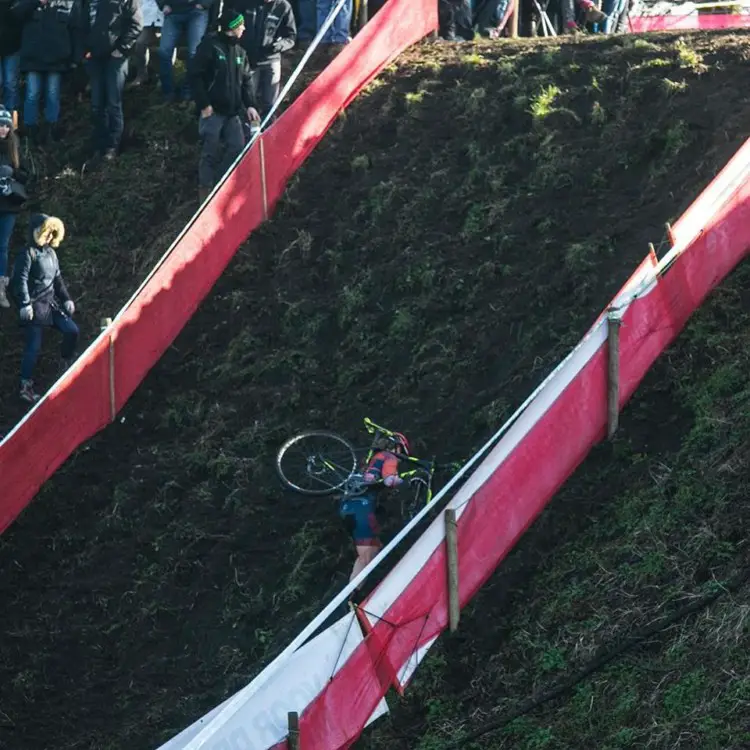
Becca Fahringer tackles one of the run-ups at Hulst. Corey Coogan Cisek rider diary. © Hans van der Maarel / Cyclocross Magazine
My pre-ride didn’t go well. I attempted the lesser of the two drops four times, crashing three of four times and knocking my wheel out of alignment. Not even attempting the bigger of the drops, I faced the fact that I was going to have to run both drops, rendering me not competitive.
The first two laps of the race, I did indeed run, causing me to lose places and forcing me to fight my way back to those riders over the remainder of the lap. Yet, I am so competitive and stubborn, I decided I had to give the drops a try. What did I have to lose? Well, other than bones, muscles and ligaments.
Hands in the drops, sternum to saddle, I did it! I rode the drops clean the rest of the race and also cleaned an off-camber that relatively few were riding. It’s amazing what you can suddenly do under the pressure of racing.
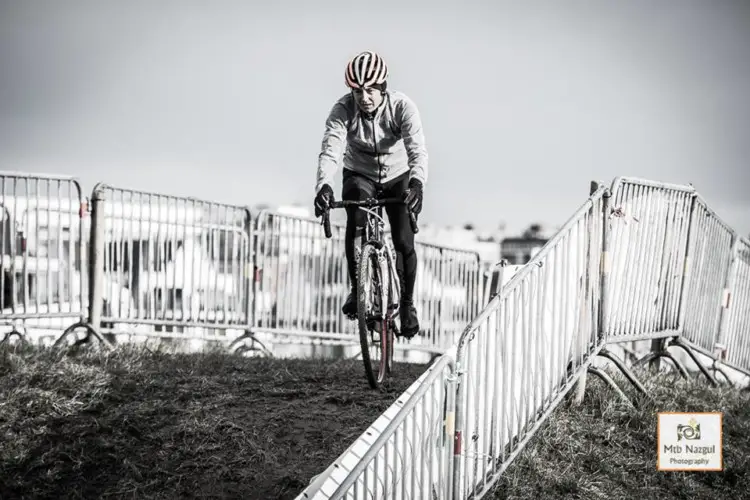
Middlekerke was one of Corey Coogan Cisek’s last races of her Euro adventure. Corey Coogan Cisek rider diary. © Nazgul MTB
I return to the U.S. with newfound confidence. The most difficult and defining features of American courses — the Pan Am Plunge or the off-camber at Louisville’s Joe Creason Park — would only be average, not extraordinary, features on European courses.
In Hulst, I also found my legs and my fight. This might have been my mental state. The night before I stayed up until 12:30 in the morning, enjoying dinner with my Belgian friends. Mind you, 12:30 is well past my bedtime, yet the party was a chance to celebrate what was so great about Belgium: friendship and feeling truly supported as a rider. As they say, “happiness watts.”
For my last column about my European racing experience, I’d like to offer some general insights about the trip as a whole.
The Flemish and Dutch are tougher than us
As an American athlete, I have been taught to think of temperatures in the 30s and rain as “hypothermia weather.” Growing up ski racing in the Northeast, I was expected to memorize the symptoms of hypothermia and be aware of the risks while in the backcountry. As a rider, I consider the physiological stresses of cold, wet weather and make the call to train inside as appropriate.
As I drove around Belgium in my nice warm rental car, I could not help but notice people, young and old, biking everywhere in all sorts of weather during the day and at night. My housemate, who is not a cyclist per se — except in the way that EVERY Flemish person is a cyclist — would grab her bike and ride into town without a hat or gloves on the worst of days.
One day, I began my ride in light rain, which became a steady downpour. I was supposed to do intervals, but every time I slowed for a rest, my core temp would fall. I could stay warm only if I stayed on the gas. Frustrated, I made the tough decision to end the workout. Since I had awoken that morning with a scratchy throat, I reasoned, “the last thing I want to do is ruin my season on one set of intervals.”
As I rode home at tempo, I saw an older gentleman riding his city bike toward me. He was wearing cotton pants, a cotton overcoat, no hat and no gloves. His one concession to the weather was he rode one-handed with the other hand in his jacket. He appeared, however, to be in no real haste to get where he was going.
Yes, the physiological stresses of getting cold and wet are real, and yet after three months in Belgium, perhaps the stress I feel encountering this weather is a little overblown.
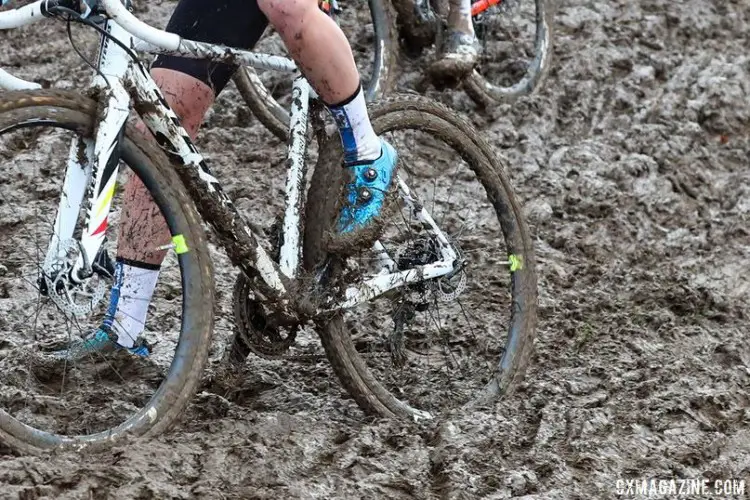
Conditions are tough in Europe. 2018 Cyclocross World Championships, Sanne Cant’s Stevens Super Prestige. © B. Hazen / Cyclocross Magazine
Elite riders are just like us, only different
To be honest, I never had the nerve to introduce myself to Sanne Cant, Marianne Vos or any of the other Flemish/Dutch greats, so what follows is purely observation.
I never felt intimidated pre-riding or being at the start/finish/around the campers with the best in the world. While I’m sure Worlds was different, the pre and post-race scenes at a typical UCI race are pretty chill (at least by the end of the season).
At Lille, I stood by Sanne, Loes Sels, Maud Kaptheijns and other elites as we waited for pre-ride to open. Though I could not understand the Dutch they were speaking, there was plenty of smiling and laughing — it was a seemingly a congenial atmosphere. The only difference between Sanne and the rest, really, is she paused her conversation no less than three times to pose with her arm around a fan for a picture.
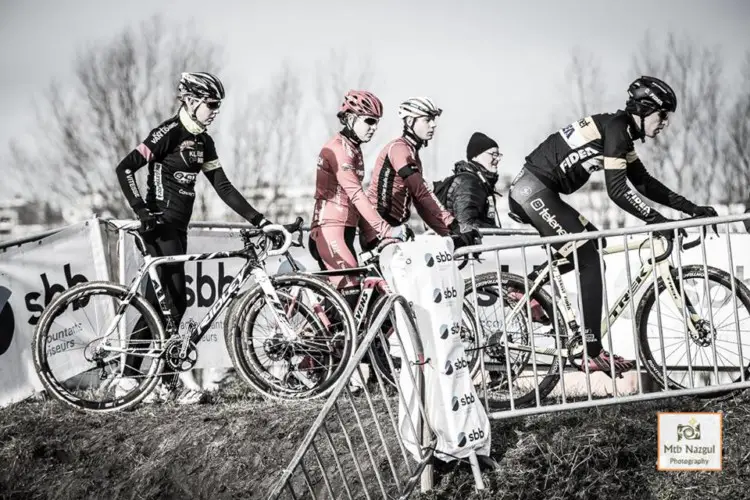
Riders wait to get on the course for pre-ride at Middlekerke. Corey Coogan Cisek rider diary. © Nazgul MTB
While there is always the adage, “they put their pants on one leg at a time,” I suspect that some of it can be attributed to culture. Stark inequities between the pay and treatment of female and male cyclocrossers in Europe remain. Perhaps I don’t feel that different from the pro women because, sadly, their lives are not as different from mine as they should be. They lack the pay and prestige they deserve. The upside of this might be a certain humbleness and approachability.
Racing in Belgium is exciting and challenging because the best riders in the World are at every race. With all the races within driving distance and promoters recognizing the need to pay start money to bring in the top riders for a profitable race, there is no such thing as a “small UCI C2.” The smallest, least prestigious UCI race I did was Rucphen, the day before Hoogerheide, and yet I lined up within arm’s reach of former World Champion Thalita de Jong.
However, the bottom third to half of the Women’s field is not unlike it is in the U.S. It is made up of under-23 riders, adults with day jobs (including some moms) and couple of former greats who still race for fun. At this time, one need not be a World Cup-caliber UCI racer to race in Belgium … assuming you are willing to eat some humble pie and struggle to finish on the lead lap.
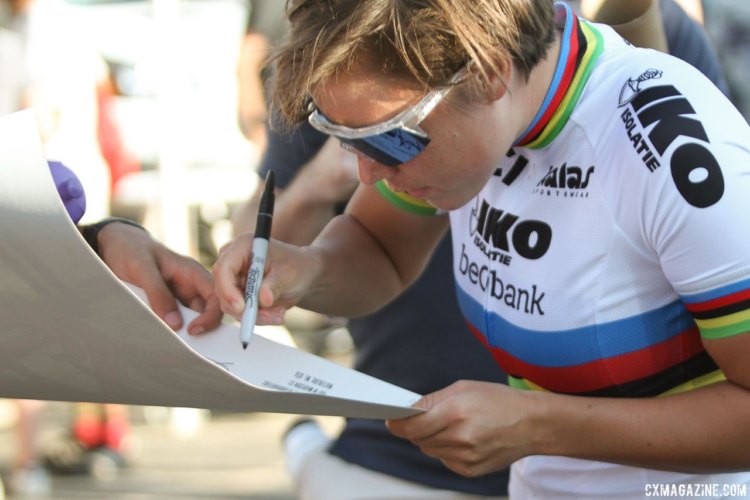
Sanne Cant and other women riders are very accessible, even at European races. 2017 World Cup Waterloo Elite Women. © D. Mable / Cyclocross Magazine
Marginal Losses
The first season as a foreigner in Belgium is one of marginal losses.
I am proud of the way I lived day-to-day life in Belgium. I enjoyed myself, nothing ever felt totally overwhelming and with rare exception I was never sad, despite being thousands of miles from home in a gray, rainy country.
However, over the course of the season, the small stresses added up. Instead of the marginal gains we all seek, I suffered from marginal losses.
Those Flemish/Dutch riders whom I said are not all that different? A significant difference between them and me is they are able to go home between races, sleep in their own beds and go about their daily routine within their normal social network. I, however, left my husband, job and social network, and moved an ocean away to a place where I knew exactly three people. Central nervous system stress is real and after this experience, I know marginal losses are as well.
It takes a village
They say Flemish people are reserved and standoffish. I totally don’t get it.
Maybe I got lucky, but I built a tremendous support network in Belgium. At the core were the mechanics I worked with. I think it’s surprising for Americans to learn many of the mechanics and soigneurs working in Belgium have a day jobs. This was the case with my mechanics, who used their vacation time to stand in the mud and the rain doing this difficult job. This speaks to the place of both hard work and primacy of cyclocross in their culture.
Besides providing the best mechanical support imaginable, my team became my greatest supporters. Despite unimpressive results, they never lost interest or stopped believing in me. They identified and celebrated little victories when I had races that were somewhat stronger than the others.
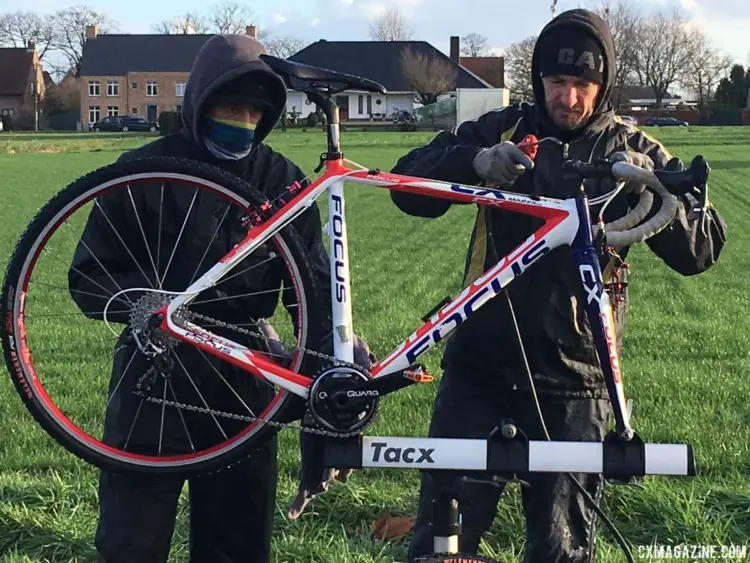
The author’s mechanics can’t stop when it comes to keeping her bikes in working order. photo: Corey Coogan Cisek
Likewise, I worked with a massage therapist who saw me weekly, in the evenings after his day job. He is tremendously knowledgeable and skilled, and did me the favor of setting a price I could afford.
Belgian fans have been widely criticized for only cheering for their favorite riders. That generalization is partially true. Certainly, the crowd does not roar in ways I have occasionally experienced in the U.S. (like at Nationals in Bend). However, I can say, that it’s not hard to become a favorite rider.
It was staggering to see the number of rider cards I gave out, friend requests I received on Facebook and to hear my name cheered all over the course. By the end of the season, I regularly heard my name with a Flemish accent (“Corwey”) all around the course. It was always a little reminder to never let up!
Flemish/Dutch fans are knowledgeable. No matter how far back I was in the field, if I did something skillful, like riding a tough section, I would hear cheers. Foreign riders are not treated as an amusing spectacle, but are instead respected for having the nerve to commit to racing in Europe.
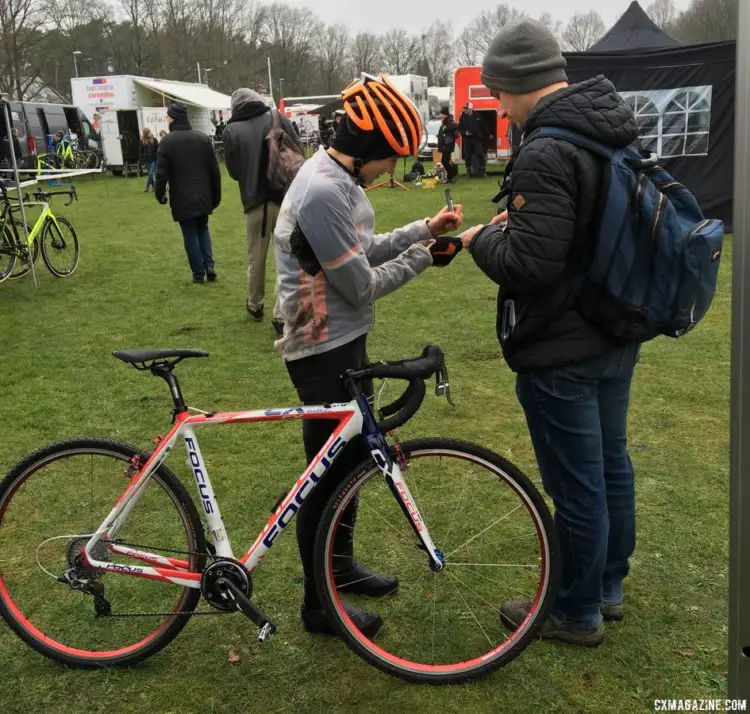
Coogan Cisek felt accepted by the Belgian fans and signed a fair number of rider cards during her racing days. Corey Coogan Cisek rider diary. photo: courtesy
To master Belgium, you must go to Belgium
I think, for some people, Belgium gets under your skin. It’s an itch you can’t scratch enough. For those trying to succeed on the World Cup, Belgium becomes a necessity: learn how to ride there or you won’t be successful internationally. For us mere mortals, we take a short trip and the place captures our imagination. We fall in love with this very different version of cyclocross and become highly motivated to figure it out.
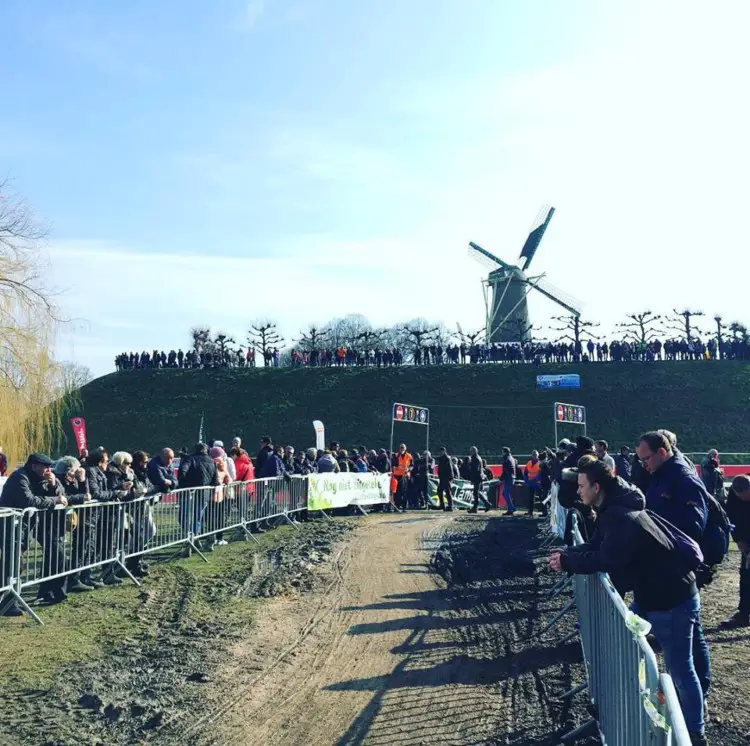
The allure of racing in Belgium is hard to resists, especially after you get a taste of it. © Hans van der Maarel / Cyclocross Magazine
Eric Thompson is one such individual who has become enchanted by the allure of Belgium. This year was a return trip to Belgium for Eric. On one of our final evenings in Belgium, we discussed how to train for Belgium while in the U.S.
While there were jokes about sending shipping containers of mud and sand to America, the challenges are real. We have sand in America, but how do you create foot-deep corner ruts without other riders to help? Without the water-management problem of the low countries, ditches and short, steep plateaus are hard to come by. The mud in Belgium and the Netherlands is conducive to developing sharp-edged, tire-width ruts. The depth and narrowness of these ruts is unlike anything I have seen in the U.S., almost like what would happen if you buried a garden house and then peeled it out of the ground.
The power requirements are quite different as well. Many of the courses, such as Middelkerke, are a series of short, sharp, steep ups that require maximum three to five-second power. Between these ups, flyovers, and accelerations around corners, you can anticipate repeating three to five second efforts 40 to 60 times a race. Likewise, there are traditional Belgium “tractor pulls,” courses that are nearly 100 percent high power/low cadence.
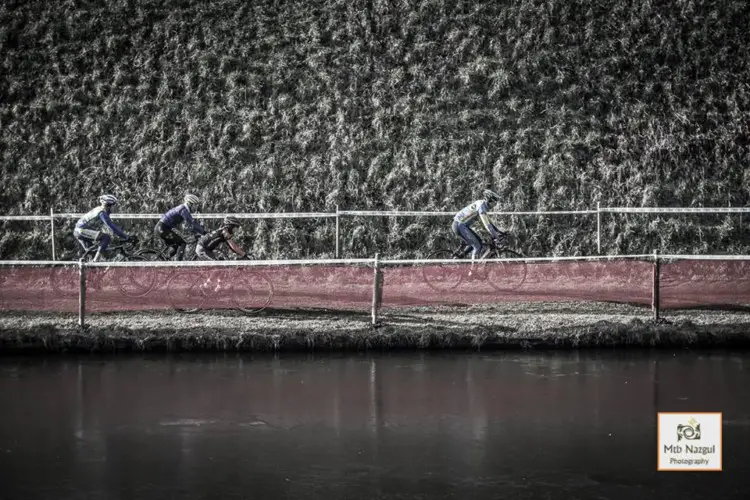
Canal banks are used for elevation at Hulst. Corey Coogan Cisek rider diary. © Nazgul MTB / Cyclocross Magazine
Success … ?
Was I successful? It depends on how you define success.
My two cents: in your first full season in Belgium, you will underperform. I had no illusions of grandeur, but I did expect to perform to my own capacity. Instead, I never quite felt like myself. Initially, I felt like a baby deer on ice. I had good power relative to the riders I was around, but they dropped me using their technical skills and line choices. Later, by the time I developed some skill, my form and ower, had left me.
My stated goal of learning to ride Belgian ’cross in a season? Totally and completely laughable in retrospect.
The biggest success of the season was learning, weekend after weekend, what I could not do. As I have outlined, I now have a much better understanding of the technical and physical requirements for success in Belgium. However, the timeline for making such physiological changes and technical improvements is much more than three months!
If I learned anything during my three months in Belgium, it is that you can watch Belgian cyclocross over the internet and even go to Belgium and watch the racing live, but nothing compares to the knowledge gained by living Belgian cyclocross for an extended period of time.
Many days, Belgium was a slap in the face and a kick in the pants, but sometimes such “lessons” are priceless.























